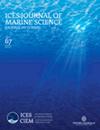Calibrating ecosystem models to support ecosystem-based management of marine systems
IF 3.4
2区 农林科学
Q1 FISHERIES
引用次数: 0
Abstract
Ecosystem models, such as Ecopath with Ecosim (EwE), provide a platform to simulate intricate policy scenarios where multiple species, pressures, and ecosystem services interact. Complex questions often return complex answers, necessitating evidence and advice to be communicated in terms of trade-offs, risks, and uncertainty. Calibration procedures for EwE, which can act as a source of uncertainty and bias in model results, have yet to be explored in a comprehensive way that communicates how sensitive model outputs are to different calibration approaches. As the EwE community has grown, multiple divergent approaches have been applied to calibrate models through the estimation of vulnerability multipliers: parameters that augment the consumption rate limits of predators. Here we explore the underlying principles of vulnerability multipliers as well as existing calibration approaches and their justification. Two case studies are presented: the first explores how vulnerability multipliers emerge based on the chosen calibration approach using simulated data, while the second takes two operational EwE models (Irish Sea and Northwest Atlantic Continental Shelf) and compares their outputs when calibrated following alternate calibration approaches. We show how calibration approaches can impact model-derived advice and provide a list of best practice recommendations for EwE calibration.校准生态系统模型,支持基于生态系统的海洋系统管理
生态系统模型(如 Ecopath with Ecosim (EwE))提供了一个平台,可模拟多种物种、压力和生态系统服务相互作用的复杂政策情景。复杂的问题往往会得到复杂的答案,因此需要根据权衡、风险和不确定性来传达证据和建议。EwE 的校准程序可作为模型结果中不确定性和偏差的来源,但目前尚未对其进行全面探讨,以说明模型输出对不同校准方法的敏感程度。随着 EwE 社区的发展,多种不同的方法已被用于通过估计脆弱性乘数来校准模型:这些参数可增加捕食者的消耗率限制。在此,我们将探讨脆弱性乘数的基本原理以及现有的校准方法及其合理性。本文介绍了两个案例研究:第一个案例利用模拟数据探讨了脆弱性乘数是如何根据所选校准方法产生的;第二个案例采用了两个正在运行的 EwE 模型(爱尔兰海和西北大西洋大陆架),并比较了它们在采用其他校准方法进行校准后的输出结果。我们展示了校准方法如何影响模型得出的建议,并提供了一份 EwE 校准最佳实践建议清单。
本文章由计算机程序翻译,如有差异,请以英文原文为准。
求助全文
约1分钟内获得全文
求助全文
来源期刊

ICES Journal of Marine Science
农林科学-海洋学
CiteScore
6.60
自引率
12.10%
发文量
207
审稿时长
6-16 weeks
期刊介绍:
The ICES Journal of Marine Science publishes original articles, opinion essays (“Food for Thought”), visions for the future (“Quo Vadimus”), and critical reviews that contribute to our scientific understanding of marine systems and the impact of human activities on them. The Journal also serves as a foundation for scientific advice across the broad spectrum of management and conservation issues related to the marine environment. Oceanography (e.g. productivity-determining processes), marine habitats, living resources, and related topics constitute the key elements of papers considered for publication. This includes economic, social, and public administration studies to the extent that they are directly related to management of the seas and are of general interest to marine scientists. Integrated studies that bridge gaps between traditional disciplines are particularly welcome.
 求助内容:
求助内容: 应助结果提醒方式:
应助结果提醒方式:


